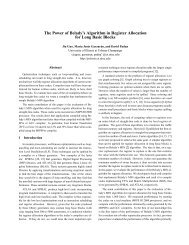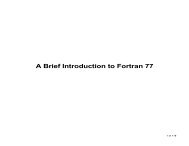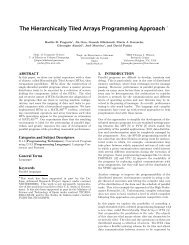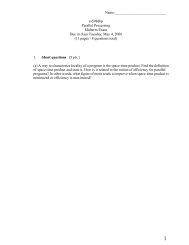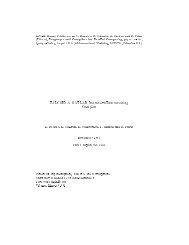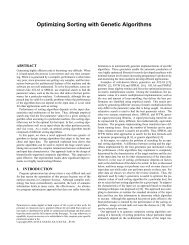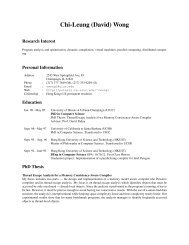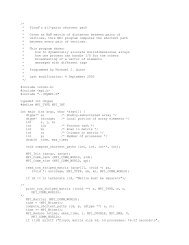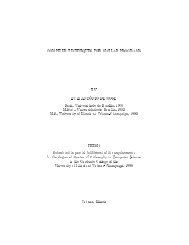Abstract Syntax Trees The Abstract Syntax Tree (AST) - Polaris
Abstract Syntax Trees The Abstract Syntax Tree (AST) - Polaris
Abstract Syntax Trees The Abstract Syntax Tree (AST) - Polaris
Create successful ePaper yourself
Turn your PDF publications into a flip-book with our unique Google optimized e-Paper software.
When there are references to array elements and to pointers, we need to<br />
make sure that:<br />
1. Common subexpressions are properly identified<br />
2. <strong>The</strong> order of instructions generated from the DAG is correct.<br />
With the DAG it is easy to determine which identifiers have their values<br />
used in the block. <strong>The</strong>se are the identifiers for which a leaf is created.<br />
Also, it is easy to determine the statements that compute values that<br />
could be used outside the block. <strong>The</strong>se are the statements whose<br />
associated node, m, still has its left hand side, x, in ID(m) at the end of<br />
the algorithm.<br />
To improve the chances of finding common subexpressions,<br />
commutative operations should be normalized. For example,when both<br />
operands are variables, alphabetical order could be used. Also, if one of<br />
the operands is a leaf and the other an internal node, the leaf could be<br />
placed on the left.<br />
Constant folding can be applied by replacing the nodes that evaluate to a<br />
constant, say c, with a node m such that VALUE(m) is c.<br />
<strong>The</strong> previous algorithm was introduced by Cocke and Schwartz and is<br />
known as “Value Numbering of Basic Blocks”.<br />
To make sure that common subexpressions are correctly identified an<br />
extra bit is added to each node. Every time there is an assignment to an<br />
element of an array, all nodes representing elements of that array are<br />
killed by setting the bit. <strong>The</strong> ID of a killed node cannot be extended with<br />
new variable names. That is, they cannot be recognized as common<br />
subexpressions.<br />
Also, when there is an assignment of the form *p :=a all nodes in the<br />
DAG must be killed if we don’t know what p might point to.<br />
Similar observations could be made about formal parameters when the<br />
language allows aliasing.<br />
To guarantee correct order of generated instructions, the DAG could be<br />
extended with arcs that enforce the following rules:<br />
1. Any two references to an array one of which is a write, must be<br />
performed in the orginal order.<br />
2. Any two references, if one is a write and at least one of the references<br />
is through a pointer must be performed in the original order.<br />
19<br />
20



